
Emmer is an awned type of wheat. It is a tetraploid. The domesticated types are Triticum turgidum subsp. dicoccum and T. t. conv. durum. The wild plant is called T. t. subsp. dicoccoides. The principal difference between the wild and the domestic forms is that the ripened seed head of the wild plant shatters and scatters the seed onto the ground, while in the domesticated emmer, the seed head remains intact, thus making it easier for people to harvest the grain.

Paleoethnobotany, or archaeobotany, is the study of past human-plant interactions through the recovery and analysis of ancient plant remains. Both terms are synonymous, though paleoethnobotany is generally used in North America and acknowledges the contribution that ethnographic studies have made towards our current understanding of ancient plant exploitation practices, while the term archaeobotany is preferred in Europe and emphasizes the discipline's role within archaeology.
The Pfyn Culture is one of several archaeological cultures of the Neolithic period in Switzerland. It dates from c. 4300 BC to c. 3500 BC.
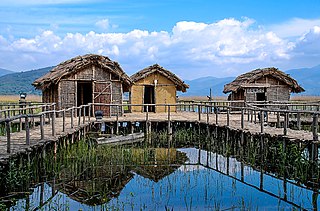
Dispilio is a village near Lake Orestiada, in the Kastoria regional unit of Western Macedonia, Greece. Near the village is an archaeological site containing remains of a Neolithic lakeshore settlement that occupied an artificial island.
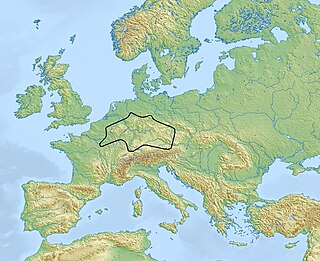
The Michelsberg culture is an important Neolithic culture in Central Europe. Its dates are c. 4400–3500 BC. Its conventional name is derived from that of an important excavated site on Michelsberg hill near Untergrombach, between Karlsruhe and Heidelberg (Baden-Württemberg), Germany.
The Subneolithic is an archaeological period sometimes used to distinguish cultures that are transitional between the Mesolithic and the Neolithic. Subneolithic societies typically adopted some secondary elements of the Neolithic package, but retained economies based on hunting and gathering and fishing instead of agriculture. For the most part they were sedentary. The Subneolithic dates to the period 5000/4000–3200/2700 BCE in Scandinavia, north and north-eastern Europe.
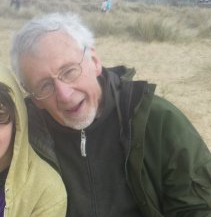
Gordon Hillman was a British archaeobotanist and academic at the UCL Institute of Archaeology. He has been described as "a pivotal figure in the development of archaeobotany at the Institute of Archaeology at University College London, [who] through his research, publications and teaching had a major influence on the field worldwide."
Hallur is an archaeological site located in the Haveri district, in the Indian state of Karnataka. Hallur, one of South India's earliest Iron Age sites, lies in a semi-arid region with scrub vegetation, located on the banks of the river Tungabhadra. The site is a small mound about 6.4 m high. The site was first discovered by Nagaraja Rao in 1962, and excavated in 1965. Further sampling was carried out in the late 1990s for the recovery of archaeobotanical evidence and new high precision radiocarbon dates

In archaeology, a biofact is any organic material including flora or fauna material found at an archaeological site that has not been technologically altered by humans yet still has cultural relevance. Biofacts can include but are not limited to plants, seeds, pollen, animal bones, insects, fish bones and mollusks. The study of biofacts, alongside other archaeological remains such as artifacts are a key element to understanding how past societies interacted with their surrounding environment and with each other. Biofacts also play a role in helping archaeologists understand questions of subsistence and reveals information about the domestication of certain plant species and animals which demonstrates, for example, the transition from a hunter-gatherer society to a farming society.
The Horgen culture is one of several archaeological cultures belonging to the Neolithic period of Switzerland. The Horgen culture may derive from the Pfyn culture and early Horgen pottery is similar to the earlier Cortaillod culture pottery of Twann, Switzerland. It is named for one of the principal sites, in Horgen, Switzerland.
Klaus Oeggl is a retired Austrian botanist, and deals with palaeoecology and archaeobotany. He is well known for his studies on the life-circumstances and on the environment of the Neolithic glacier mummy "Ötzi".

Kleiner Hafner is one of the 111 serial sites of the UNESCO World Heritage Site Prehistoric pile dwellings around the Alps, of which are 56 located in Switzerland.
George Willcox is an archaeobotanist who specialises in the origins of agriculture in the Near East. He has been employed as researcher with the CNRS France since 1989. He has dual French and British nationality. He studied environmental archaeology under the late Prof. Dimbleby at the Institute of Archaeology in London during the early 1970s and was then employed as environmental archaeologist by the Museum of London. In 1977 he married and left his job to follow his interest in Near Eastern archaeobotany. An interest which he had acquired as an undergraduate working with Gordon Hillman in Turkey. During the next few years he worked in Turkey, Afghanistan Jordan, Oman, Kuwait, Tajikistan, India and Syria and started amassing a charred archaeobotanical collection and modern reference collection. These are now housed at the Muséum national d’Histoire naturelle in Paris. It was during this somewhat precarious period that he moved to France and founded a family. In 1984 Gordon Hillman introduced George to Jacques Cauvin and Patrica Anderson at the CNRS Institut de Préhistore Orientale in south east France where they developed a project on experimentally cultivating wild cereals In 1989 George entered the CNRS working on a number of early Neolithic sites in Syria in particular with Danielle Stordeur at Jerf el Amhar. He lectured at several French universities on archaeobotany and the origins of agriculture and supervised post graduate students. He was an associate editor for Vegetation History and Archaeobotany for many years and received an honorary doctorate from the University of Basel in 2013. His 117 scholarly publications are a measure of his research achievements. In 2014 with statutory retirement the CNRS awarded George the status of "Directeur de Recherche Emérite, CNRS" which allows him to continue to supervise students, sit on PhD panels, peer review manuscripts and carry out field work.
Glynis Eleanor Jones FBA is a British archaeobotanist, who is Professor of Archaeology at the University of Sheffield.
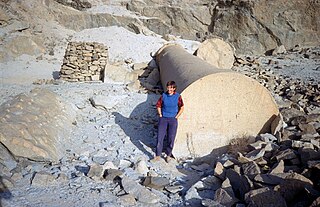
Marijke van der Veen, is a Dutch archaeobotanist and Emeritus Professor of Archaeology at the University of Leicester.
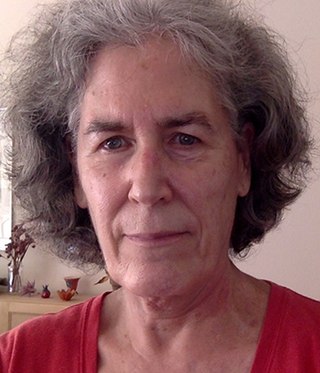
Naomi Miller is an archaeobotanist who works in western and central Asia. Miller is based at the University of Pennsylvania.
Maria Hopf was a pioneering archaeobotanist, based at the RGZM, Mainz.

Mordechai E. Kislev is an Israeli emeritus professor in the Mina and Everard Goodman Faculty of Life Sciences at Bar-Ilan University, specializing in archaeological botany. Some of his prominent research focuses on prehistoric early agriculture and archaeological entomology. Other works explore the ancient landscape of the Land of Israel, as well as Torah and Science issues.
Meriel McClatchie is an archaeologist specialising in archaeobotany. She is an associate professor at University College Dublin.
Camilla Ada Dickson was an archaeobotanist specialising in the analysis of archaeological plant material from Scotland.









